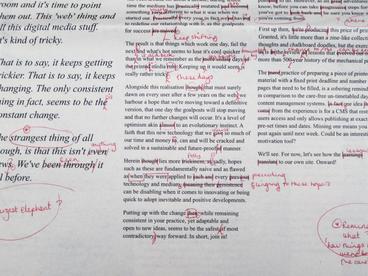
Encouraging Effective Proofreading
Few issues create more consternation among instructors than students’ perceived inability to proofread. For many instructors, typographic errors, misspelling, punctuation errors, and errors in tense, reference, and agreement may be signs of inattention to detail or deficiencies in basic skills. It almost seems that the more trivial the error, the more likely the error to solicit frustration, anger, and despair. Unfortunately, frustration with errors tends to multiply as errors multiply, even across drafts and students. This tip will identify some reasons why even advanced students might make common errors and how instructors can reinforce the proofreading habits students may have been taught, but may not apply consistently.

How writers make errors and when instructors notice
In 2008, Andrea Lunsford and Karen Lunsford identified the most common errors in student texts, replicating a series of studies that have examined where and how students make mistakes in their writing. The list includes errors in grammar, usage, style, punctuation, and vocabulary (along with examples of both the error and its remedies). Significantly, the most common errors, including word choice and spelling (including homophones), punctuation, and common usage are difficult to detect with default spelling and grammar checks.
The study challenged several common presumptions regarding student errors. For example, little evidence suggested that students’ writing had grown significantly more error-prone over time (writers in 1917, 1930, 1986, and 2006 averaged slightly more than two errors per 100 words). However, the types of errors have varied over time, and the attention to particular errors varied dramatically among instructors both across and within samples.
Research since the 1980s has suggested that cognitively demanding writing tasks increase the likelihood and frequency of writing errors. Although increased complexity can increase readers’ tolerance of error (meaning readers see fewer errors in writing they find interesting or compelling), students may find themselves facing a scenario where they are more likely to make mistakes, and their experienced instructors are less likely to ignore them.
Finally, recent research also suggests that confirmation bias may also influence readers’ error detection (readers predisposed to find errors will find more and judge errors more severely). Implicit bias may lead instructors to attend more carefully to errors in student writing, even when students and faculty do not meet face to face.
In-class strategies for helping students to proofread
Differentiate review and revision from proofreading and editing: Students should be encouraged to review and revise their writing to ensure that their work meets the expectations of audience and purpose explained in the assignment. After a process of revision, proofreading and editing are the examination of surface features of writing to identify and correct common errors. Very few writers can do both at the same time. It may be useful to demonstrate the processes of peer review common in your research field, as the distinctions between manuscript review and editing are often quite explicit.
Ask students to document their proofreading strategies: While you may not want to introduce your students to the full spectrum of copy editor’s marks, encourage students to identify their errors by type as well as to make corrections. When students identify errors by type, they can become more aware of their patterns of errors, allowing them to more readily recognize and remedy their most persistent challenges
Encourage students to proofread in multiple passes: In an initial pass, ask students to look only at the relationships between subjects and verbs, perhaps by underlining verbs in their sentences and drawing arrows to the subjects. In a second pass, ask students to check for spelling and word choice errors. Finally, ask students to examine terminal punctuation and punctuation around quoted material.
Familiarize students with built-in review tools: Many students rely on the default settings in word processing programs for their proofreading. If students are using a different software package, tool, or means of display, alert them that they may need to pay increased attention to errors.
Show students the style your field demands: Students may be familiar with conventions for writing in one field but unfamiliar with those in others. Bring copies of style guides and references common to your field and give them practice in seeking answers to their style questions.
Prepare students to notice what you notice: Because faculty vary in their attention to common errors, use previous student papers to determine which errors are most likely to catch your attention, including common homonyms and other errors that may be particular to your field or its genres.
Provide proofreading time the day the assignment is due: On the due date of the assignment, ask students to bring completed drafts of their assignments, but allow proofreading time before final submission. When required to devote time to proofreading , students are often able to detect their own errors. You may choose to allow students to resubmit an edited copy or assure students that the errors they detect and correct will be treated more graciously that those they ignore or fail to detect.
Learn more
- University of Minnesota Student Writing Support on Proofreading
- Jeff Anderson, Mechanically Inclined: Building Grammar, Usage, and Style into Writer’s Workshop
- The Chicago Manual of Style Online, Section Five, Grammar and Usage
- Log in to post comments